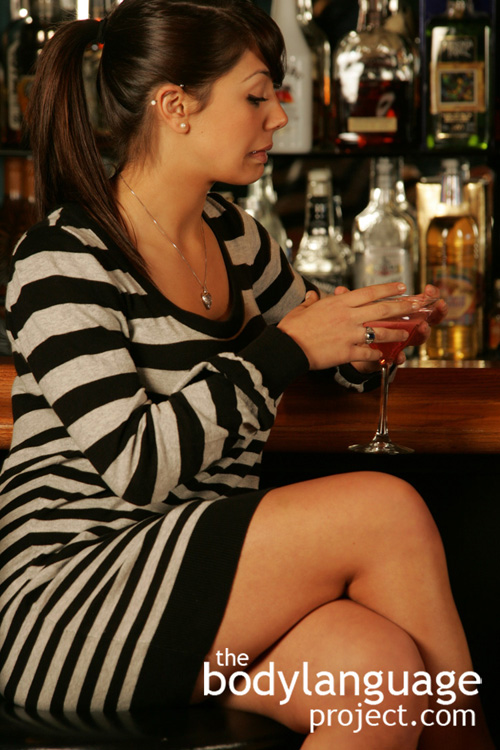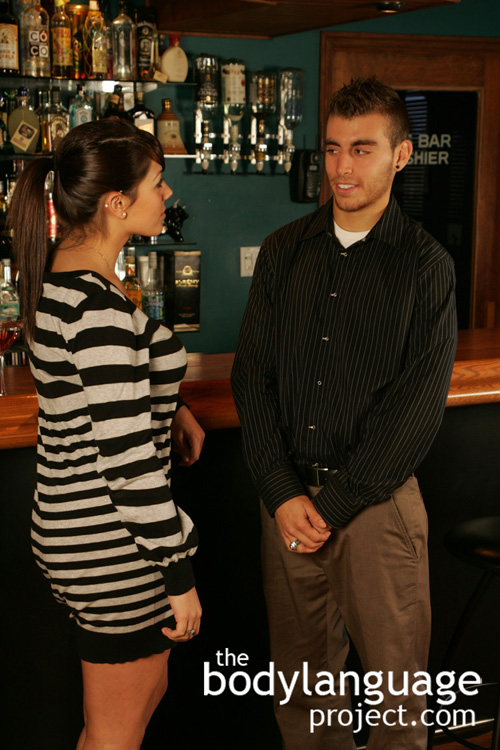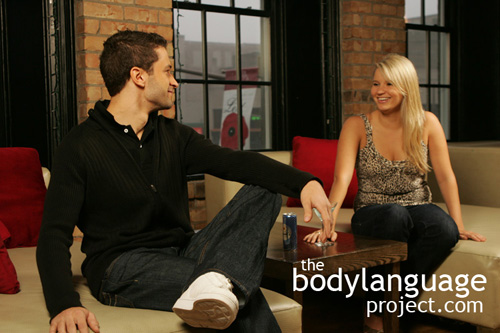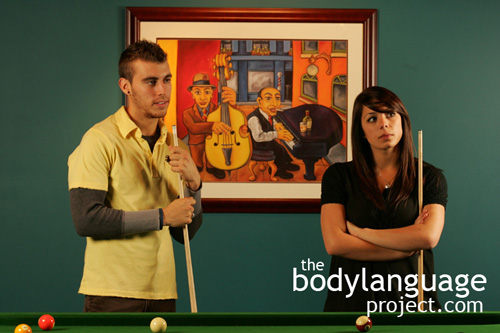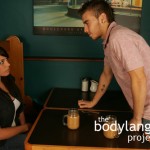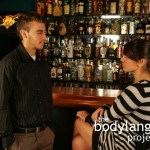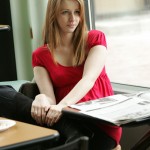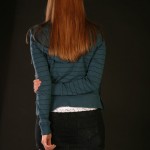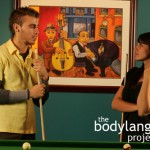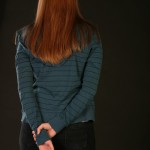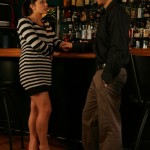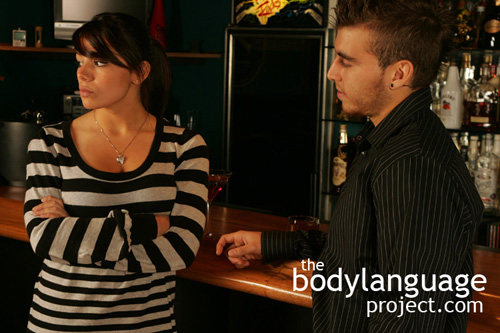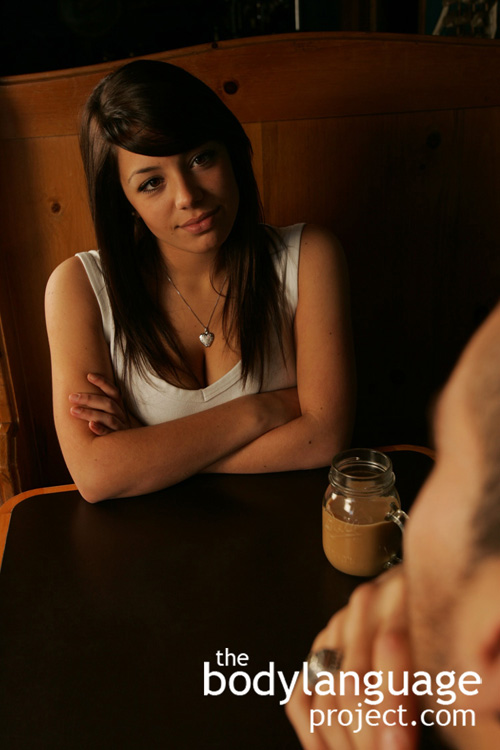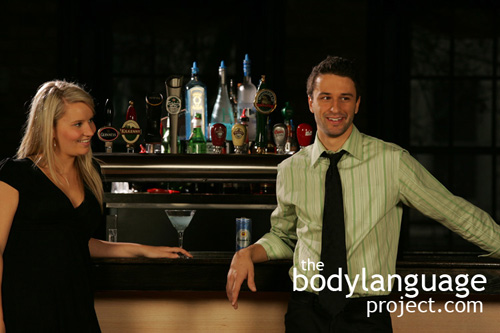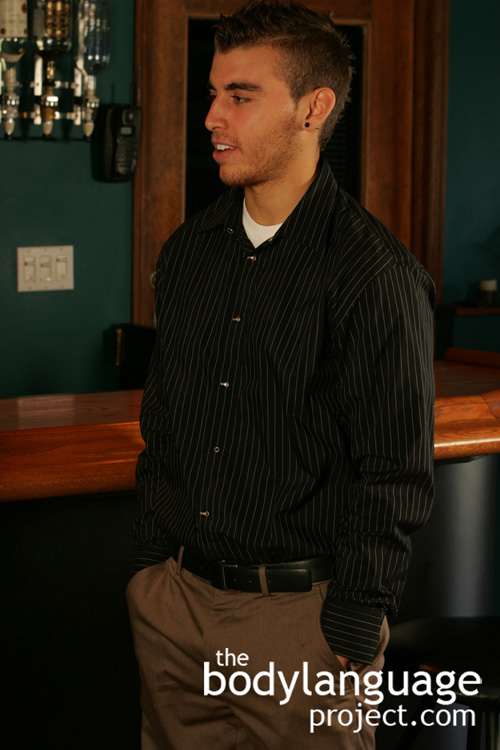The legs parallel is a sign of femininity because men aren’t easily able to perform this posture for obvious anatomical reasons and because it makes women’s legs appear toned. Men have much narrower hips than women, and an extra bit in the way, and so therefore aren’t able to sit in this fashion! The parallel legs posture occurs with one leg pressed against the other making the legs appear sexier and more youthful. Women who are trying to draw sexual attention to themselves use this sitting position. The most overt sitting posture of all is having legs spread and will attract the greatest amount of sexual attention, but appears much more crude and less feminine.
Tag Archive for Posture
Fig Leaf Position
by Chris Site Author • March 5, 2013 • 0 Comments
The fig leaf by either sex is a closed body position. It blocks the private mid section from view. This posture occurs by placing one or both hands in front of the midsection and takes its ‘fig leaf’ name from Adam and Eve’s traditionally portrayed posture in the Garden of Eden artwork. Modest men and women who find themselves accidentally disrobed will instinctively clasp their hands over their private areas. Naked women will split their attention from both breasts with one arm and hand, with the other hand over their genitals. Men will exclusively protect their genitals from view with both hands.
In real life however, will rarely find ourselves nude and exposed in public, but our minds are still hardwired to harbour feelings of insecurity from overexposure. In day to day situations women won’t be fund covering their breasts by clasping them and men won’t grab their genitals a-la Micheal Jackson, but they will claps both hands together either tightly by interlocking their fingers, or loosely with hand in hand and then casually placing them over their mid-section. Standing is the most obvious and common way that the fig leaf position shows itself, but it can also find its way in a seated position as the hands are rested on the lap. Women can and do block their chests from view, as well, but not in an offensive or obvious way. Rather, women cross their arms in front of their chests as a barrier or block their breasts from view when threatened with whatever objects they have handy, a textbook, a jacket or scarf, even bar tops.
These postures, of course, show insecurity and occur when we find ourselves in novel environments or around people we aren’t familiar with. We will often see this from less confident speakers who find themselves exposed to large audiences or when a presenter requires a participant (victim) to demonstrate a concept.
Figure Four And Figure Four Hand Lock
by Chris Site Author • March 5, 2013 • 0 Comments
This body position occurs as one leg is bent, oriented horizontally and pulled over the opposite knee, to form the number four. Hence the name, the figure four leg cross. It is more or less an open posture and should be taken as a mild version of the crotch display which we saw in the section on leg spreading. This posture is milder because it doesn’t fully expose the crotch because the crossed leg partially blocks the genitals from view. This again, is another one of the cues that where it’s useful to picture our targets as being nude. In essence this is the gentleman’s version of the crotch display. Women aren’t normally seen in this posture, but since pants have become more popular, it does tend to happen more often lately, than it has in the recent past. The figure four tells us that a person is relaxed, youthful (mature gentleman are seen with a full leg cross where the legs end up parallel to one another) and dominant.
The figure four seating position can be close off entirely by placing each hand on the shine so as to lock the leg in place. This posture indicates that someone is extremely stubborn and most likely apt to reject opinions of others. The person is also highly opinionated in most every way and may lead you into disagreement at every turn. The figure four hand lock is stronger as a signal if it is accompanied by negative facial expressions, scowls, or frowns. If selling an idea or product, it might be best to drop the pitch altogether and seek more agreeable company unless you are comfortable using extreme tact or are skilled at building relationships quickly.
The Ankle Or Scissor Cross
by Chris Site Author • March 5, 2013 • 0 Comments
The ankle or scissor cross is where the ankles cross each other and is a posture that can happen while seated or standing. While seated this posture is a hidden form of leg crossing because it occurs discretely at the bottom of the legs and can be out of sight due to a desk or table. While standing, it is the only way legs can cross so has a similar meant to a regular full blown seated leg cross. At times the leg might be raised up the backside of the calve producing the appearance of a flamingo but this posture is mainly reserved for women. While seated, the legs can also be locked behind the legs of a chair with essentially the same message being delivered except in this case it is a restraining-freeze-behaviour. When the legs are wrapped around the chair they can’t move, hence they are locked, and are also there precisely so they don’t move, and are hence frozen. Women are also seen using the sitting position more often them men especially if they are wearing skirts, however, it is not a confident posture so should be avoided. When it does happen in men though, it should be noted since it is an unnatural position in general for them.
The ankle cross indicates that the person is holding a negative emotion, uncertainty, fear, feels discomfort or threatened, stress, anxiousness, insecurity or timidity. The ankle or scissor cross also shows reservation and self-restraint,
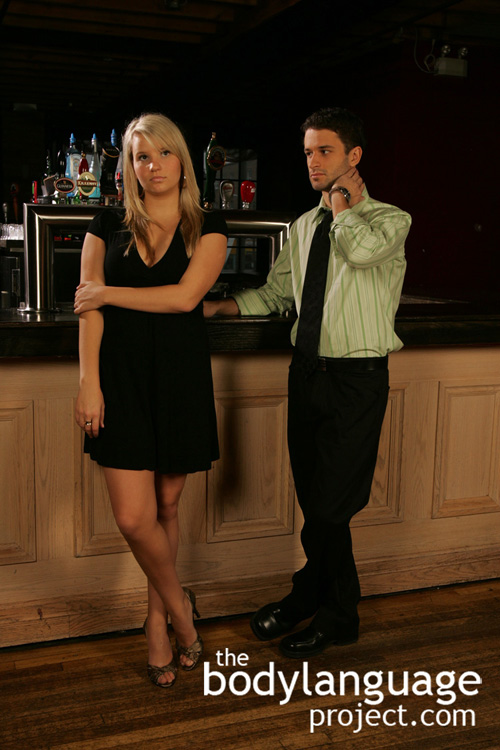
Lots of cues in concert. Arms in a partial-cross coupled with crossed ankles – and he’s not doing much better as he ‘holds himself back!’
due to withholding of a thought or emotion. When being pitched, it shows resistance to the sale and when being questioned might indicate that lying is taking place. Couple interlocked legs, which is a freeze response meant to reduce foot movement, with pacifying behaviours such as rubbing the thighs palm down, as if to dry them, and you’ve got a cluster signaling that a secret is being covered. If the feet are pulled under the chair, the message is even more exaggerated. The feet are saying exactly what the person is thinking, that he or she is closed and withdrawn from the conversation. We should be watchful of this posture when presenting a controversial opinion to see what degree of disagreement is present and especially if the posture is held for a significant length of time, particularly by men. When the ankles cross it is due to a subconscious freeze response due to a threat and the legs are entwined so as to restrict and restraint movement.
As we saw previously, closing a sale or changing opinions necessitates open minds and since our bodies and minds are linked should try to open those with the scissor posture when possible. You could try to have them change positions, as above, by having them stand or relocate to a more comfortable seating location, or you could take the time to identify and address whatever issue is of concern. This is important especially if the posture preludes a more intense selling session to follow, since negative postures early on are a good predictor of the future.

Mixed message – head cocked to the side shows interest coupled with arm and ankle crossing – she’s uncertain.
In a free-flowing interview or discussion noting the timing of ankle cross’ can prove valuable. With some research or prodding it might be possible to reveal the true reason for the action. Simply asking the reason for the reservation can help eliminate this posture as well because it will make the person feel listened. This is risky, though, because the primary reason for the gesture is to conceal an emotion. Conversely, giving someone the opportunity to express their thoughts makes people feel heard and sometimes that is all that is needed to open someone up. The posture after all, is a posture of hidden disagreement, so it would be hard to hold the posture as one is given the chance to open up. If the posture returns after some time, it might indicate that the person hasn’t fully disclosed their true opinion on the matter or that a new issue of contention has been uncovered. Therefore, once again, time should be taken to address any concerns that might have arisen before moving forward.
The Meaning Behind Arm Crossing
by Chris Site Author • March 5, 2013 • 0 Comments
Arms in the non-verbal world are shields. Folding the arms across the body is like cutting off access to our core that houses our vital organs, our heart and lungs. Just like putting up a shield, the arms protect us, not only from physical attack which can elicit closed body language, but it also protects us from unwanted outside views which we do not agree with. Therefore, having the arms across the chest can mean that either a physical threat or emotional threat is present. Arms crossed, in meeting or conversation means that the person is defensive, negative, uncertain and insecure and naturally, what is being asked of them will be met with disagreement.
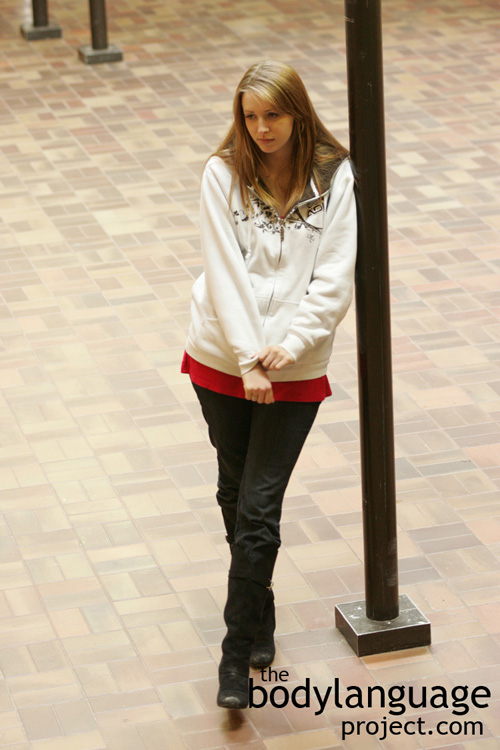
An abbreviated arm cross where the hand seems to perform a necessary task. In reality, this person feels uncomfortable and is shielding themselves.
Arm crossing happens much more frequently in public than anywhere else. We especially see it in elevators, when exposed to a large group that makes us uncomfortable or when pitched a bad deal from a door-to-door salesman. When in public, arm crossing is due to the stress of being in a novel environment rather than due to holding negative thoughts per se. Women who are unreceptive to a pick-up at a bar or club will also be found holding this posture so as to maintain their personal space and thwart sexual advances.
As you read body language, you will eventually come across someone that tries to convince you that their closed language is a function of comfort, as in it just feels right, rather than as a tell to some underlying stress. However, arm crossing is one of the gestures that proves the body language rule rather than disproves it. The research makes it clear though, that we adopt positions because there is an underlying emotion attached to it and that this is the reason which makes the position comfortable and rather than the other way around. Body language feels right when we express underlying feelings because it provides us with a release. Conversely, if we wish to avoid closed body postures, or any bad postures for that matter, we must first attack and cure the root source of the emotion and then open posture will come naturally.
Arm crossing takes up various forms too besides the recognizable full arm cross. The more evident and strong the arm crossing, the more seeded the action is in the mind of the person executing it. As body language senders we should always try to hold opened and honest body language as a default condition as it will yield the best results under most circumstances.
Here are some examples:
______________________________________________________________________________________________
[ONE] Resting one arm straight out onto the table to the front and placing the opposite hand on the wrist or forearm of the other [images show other variations of this posture].
______________________________________________________________________________________________
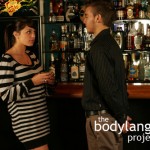
The coffee cup barrier – even drinks can fudge as a shield. To appear open, simply drop the drink to your side or set it down.
[TWO] Holding a drink in one hand with the arm perpendicular to the body (parallel to the table) with or without applying weight to the arm [image shows other variation of this posture].
______________________________________________________________________________________________
[THREE] Crossing one leg over the knee of the other and holding the ankle to lock it in.
______________________________________________________________________________________________

It looks like the conversation is going well, but the arms are being gripped showing negative thoughts.
[FOUR] Full self embrace where the arms are unlocked.
______________________________________________________________________________________________
[FIVE] The opposite hand reaches over the body to grab the elbow or shoulder of the opposite arm.
______________________________________________________________________________________________
[SIX] Subtle arm crossing where the hand grabs the wrist of the opposite side.
______________________________________________________________________________________________
[SEVEN] The arm crosses and seems to serve a supportive role.
______________________________________________________________________________________________
[EIGHT] Hand seems to alleviate an itch.
______________________________________________________________________________________________
While most closed body language means that a negative attitude is present, context permitting, there exist varying degrees. For example, full arm crossing accompanied by expressionless faces, a tense, rigid, or hostile posture with limbs that appear frozen runs the gambit of rejection. Tentative closed body language where only some blocking is happening will show a semi-relaxed body language, possible boredom, a neutral face and moderate movement of the arms and hands. In the first case, where closed language is extreme, getting any kind of agreement is unlikely. The second set of postures says that there’s a possibility of forming an agreement. So rather than depicting “no”, some closed body language says “Maybe” or “I’ll think about it.”
Opened and closed body language as we have seen is a matter of degree. Language that has no closed body positions says “yes” some closed means “maybe” and a lot means “no.” This is highly useful especially if you wish to sway a target. Men who wish to proposition women can read between the lines. If they see a half arm cross where one arm holds the elbow of the other, then he may still have a shot as she could just be timid. In this case, she is telling you that she is uneasy with your approach but might accept your proposal if you can present a better pitch. Because her mind isn’t completely made up it would be worthwhile to continue. But if she has a hostile expression, with arms tightly folded across her chest, with her head cocked to the side she probably isn’t willing to hear your pitch, so it would be a waste of time to continue. Reading negative body language can help us read employers as we look for pay raise, better deals on a watch or jewelry, getting permission from those in authority and generally gaining access to resources we ordinarily wouldn’t.
Be careful with the pressure you apply. You may be able to get a better deal from a used car salesmen, but when dealing with employees, an employer or a client, it’s probably best to keep body language open and inviting.
Being Opened And Closed Through The Legs And Arms
by Chris Site Author • March 5, 2013 • 3 Comments
Throughout this chapter being “open”, refers to a frame of mind that is willing to accept information, to hear others out and to consider taking action whereas a closed mind, or being closed indicates the opposite. As mentioned previously, having an open and receptive mind is indicated in body language through the absence of closed postures.
It has been shown that frowning requires more muscles and effort than does smiling and so naturally our default facial expression is the smile. Similarly, openness as it relates to body language is the default mode because a relaxed body requires less effort than one that is tensed or closed. To take a negative posture, we must actively close our bodies off requiring effort and to exercise effort we need motivation. In this case, motivation can come from any fearful or unwanted stimulus that precedes a fight or flight response. That is to say that, closed body language are the postures we while see as a negative decision is being analyzed and so is a predictor of a bad outcome.
Being completely open allows us take our most comfortable position, such as what we might do on a couch or in bed in our own house. We might lay our arms out and take up space, put our hands above our heads, spread our legs open or even lay down completely. Having open body postures is akin to being totally exposed to the word and all the harmful things in it, but possessing no fear of harm. Of course, we permit ourselves to hold open postures precisely because we expect nothing harmful to happen. In other words, our bodies are permitted to relax when we are open and contract and tighten when we are closed.
Thus, it takes muscular effort to close the body off whereas open postures occur without action at all. When viewing open body language imagine the extremity of the postures, which as mentioned, can be likened to being on a couch at home. An even more dramatic example is to view open body language as that language exhibited by someone who is intoxicated. Their language is loose, their arms sway freely, they stagger, they have no worries about being ridiculed or attacked and they don’t cross their arms or legs. The cerebral cortex of the drunk, the part of the brain that helps in judgment, amongst other brain centers, is disrupted producing depressed inhibition, increases talkativeness and makes people feel more confident. Alcohol also increases pain thresholds, numbs pain, and makes people feel sluggish because it suppresses the brains ability to function. So for our purpose, the drunk makes a nice example of open body language since he lacks fear, but even if he did, he’d still lack the coordination and strength to carry out a defensive posture.
As a rule of thumb, closed body language happens whenever one of our limbs crosses the mid-point of our bodies. Such is the case during leg and arm crossing. Open postures, on the other hand, happen when the legs and arms remain un-crossed leaving the torso and groin exposed. Of course there are various ways in which the legs and arms can be crossed and these all mean different things which we cover next.
Sudden Changes In The Hands
by Chris Site Author • March 5, 2013 • 0 Comments
Hands can show real-time changes in an attitude. Imagine a couple sitting enjoying a romantic meal at a restaurant, with their hands bridging the gap between them as they sit facing one another hand-in-hand. The topic of conversation flows freely, but suddenly switches to a contentious issue, what would you imagine would happen to their hands? When there is disagreement between people, the hands are pulling inward and away from those we disagree with. This sort of behaviour can happen suddenly especially on a heated topic, but can also happen over time on issues that gradually show differences. When total disagreement is present, the body will even be withdrawn where the hands will rest on the lap. Taking the example of the couple above once again, imagine that only one of the two experiences a change in thought to the topic, their hands might remain outstretched in the center of the table and turn palm up as if to offer the idea to their partner as if to try to change their mind. Gradually the other might re-advance to join their hands once again or move them to their lap. As the argument fails, both parties hands might graduate away. If disagreement continues, feet might orient toward the door followed by torsos than finally their heads.
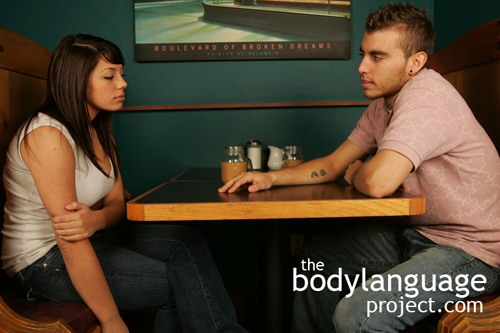
Arms are withdrawn when disagreement is high. These arms are busy protecting the torso in a single arm closed body posture – an ‘incomplete hug.’
Arms withdraw for a number of reasons but our subconscious mind tunes into our flight response and pulls hands in when we fear they will be hurt, and especially when they are hurt. When we touch a hot stove or hear a loud bang, our arms draw quickly into our bodies to protect them. This happens instantly with no ability to stop it. Likewise, our hands come in when we are worried or threatened despite a lack of physical threat. When our arms come in, our minds feel that they can block attacks better even when they are emotional in nature. Hands can be withdrawn for any number of reasons, not just disagreement, such as dishonesty. Honest hands are palm up, offering something to another person, or palm down in a confident authoritative position, but when hands are pulled away, they signal hidden thoughts of disagreement and lack of connectivity.
Hands can also suddenly change in terms of use of illustrators and seem to pause, stop or slow in their rate of use. Sudden cessation of gesticulation can indicate a freeze response due to being caught in a lie especially when the context warrants it. This is part of the flight or flight response as liars are trying to seem less noticeable. They are “hiding in plain sight” and to do this it is necessary to move less as movement attracts attention. Reducing expressiveness means fewer “tells” or so the lying mind thinks. When hands that are usually busy while talking according to a baseline, suddenly begin to slow, or become less expressive, it can signal a lack of enthusiasm or confidence for the topic. Whatever happens to the hands, when they suddenly change, we know that something internal has changed and it is usually tied directly to whatever is happening in the moment.
Hands And Palms Language
by Chris Site Author • March 5, 2013 • 0 Comments

The “offerer” in the rogatory posture wants to give you his thoughts and just doesn’t understand your point of view.
The human brain has been shown to place a disproportionate amount of attention on the wrists, palms, fingers and hands compared to the rest of the body. Throughout evolution as we developed the ability to walk upright, our brains became fixated on what our hands were doing because they became more expressive in language through gesticulation, became more skilled such as creating fires, catching prey, collecting berries and building structures and tools to do so. However, our where our hands differ significantly from our feet is their ability to become extremely dangerous. Hands coupled with weapons can inflict deadly blows.
Being open means being honest and not hiding anything. In evolutionary terms, the palm display is an important gesture signifying honesty because it is a way to make evident to others that no threat or weapon is present. Palm and wrist displays have even been noted to be sexual in nature and more frequently flashed by women during courtship likely because it is such a vulnerable part of the body. The wave, as a long distance greeting, probably has roots in showing that we aren’t carrying a spear, sword, or bow and arrow. Having the hands deep in a pocket or behind the back can be a sign of aggression or passive threat, and our evolutionary history tells us that someone who is hiding something is probably not hiding a bouquet of flowers. But if they are, why take the risk! Showing open palms, facing up, or the “palm flash” is essentially what would have happened thousands of years ago when two foreign tribes met. Even today we might guess that a stranger approaching us on the street was up to no good if they hid their hands at their backs or tucked inside a jacket. We’d think they were harboring a gun and planned to rob us.
Having the arms out and extended, palms up, or vertical shows that we are safe and therein lies our most popular greeting, the handshake. The degree to which this openness occurs represents the degree of openness. Having the arms completely to the side or up and open with fingers apart is as open as one can get and it signal as much. We rarely see this form of openness, rather, openness is of degree, so we therefore must look for more subtle and acceptable cues.
Open gestures are accompanied by phrases such as “Trust me.”, “I wouldn’t lie to you.” and “What, you don’t believe me?” We also gesture with palms facing upward when we are offering something. However, the offering, in this context, isn’t a tangible item, rather, it’s an idea. It could be a cell phone plan coming from a salesman in the mall, or a reorganizing of the company, a downsizing, or new way to deal with customers or any number of things requiring deal making or selling.
When the arms are completely outstretched with palms up we call it the “rogatory” posture, or prayer-like. It is as if we are offering dialogue to another and sincerely want to be believed, trusted and accepted. This posture is not dominant or even confident however, because it lacks conviction. So while palm flashes show honesty and trustworthiness because they show no threat, they lack sustenance and power in terms of conviction. Palm down displays though, by placing hands face down on a table or standing head on and leaning with the fingertips spread to anchor the body shows emphatically that a position is held confidently. While conversing on a topic, we should therefore expect both palms up and palms down as opinions are either offered with reservation or presented with conviction. Depending on your position on the matter you may wish to employ either submission or dominance to your advantage. For example, on issues you wish to concede or are unsure of, of which making the other party aware of this fact is acceptable, use palm up, but when you wish not to concede or wish not to be uncovered as unsure, keep palms face down. The rule of thumb is that palms down “tell”, while palms up, “offer.” When someone wishes to display honesty, such as declaring “You have to believe me, I didn’t do it” they should use palm down displays otherwise they may not be telling the truth and expect not to be believed.
So why do we find it comfortable to put our hands in our pockets? Our clothing, especially that of men’s, is specifically designed with this in mind. The fashion of women rarely permits the luxury of the same deep pockets, but this isn’t to say they wouldn’t take advantage of them if they could. Curiousity says that we must reason why this is so. What is it about this hand placement that makes us more at ease? Are men more reserved to the point of requiring their garments to accommodate their needs or is it just superfluous? There’s no doubt that form meets function in this case, and putting our hands in our pockets makes us feel more comfortable and gives us a way to occupy our hands, but what does the body language convey to others?
When children lie they can be found to place their hands behind their back concealing them. This is a dishonest gesture. As we grow into adulthood, this gesture becomes more condensed and our hands find a new place in pockets. Seeming outright dishonest for having your hands buried in pockets is a bit extreme, but context specific could be a ‘tell.’ Regardless though, hidden hands convey a lack of confidence especially when the hands would be best served to gesture appropriately in conversation. The hands are a very effective way to colour our dialogue and make us appear more honest and intelligent. When delivering important information showing the flesh of the palms, the “palm flash” can be critical to portray honesty. At a subconscious level, as the palms are made more visible, the more honest others will find the speaker. Give it a try!
Introduction – Chapter 7
by Chris Site Author • March 5, 2013 • 0 Comments
Openness can sometimes be confused with simply being relaxed or intense, and to some degree this is true. For example, being open often means that attire is also relaxed, shirt collars are unbuttoned, ties removed, the pants might hang loose and certain articles like jackets might be removed. Full openness, therefore, is not always acceptable. Conversely, we might look at being open as simply a lack of holding closed cues. That is, having open cues is the exact same as not displaying closed cues and is the default position of the two. Being closed requires a certain amount of tensing of muscles and therefore effort so the default of most people is having an open mind. In other words, people are open, unless they say otherwise! It follows that there are far fewer cues to symbolize openness as opposed to closed, since being open is more of a passive state.

Closed body language happens whenever a part of our body crosses the center-line. Arms are shields that protect our torso from harm.
When closed postures are combined with other closed postures, the signal intended is made more obvious. For example, leg crossing in combination with arm crossing is much more potent than either alone. Add to this an expressionless face, turning away, and one is left to assume that communication is not welcomed at any level. On the other hand, we might be faced with someone who has their legs crossed but the arms are opened and honest. In this case, we might assume that it is a deliberate and conscious attempt to appear relaxed, when in fact the person might not be relaxed at all. It might be the case too, that someone has mixed feelings and is reserved at one level, but open at another level. Reading opened and closed body language is tricky business, but all cues are additive. Cues of the same origin, happening together, serve to strengthen an open or closed reading, but so too does conflicting cues. Conflicting cues tell us that someone has an internal reservation, made obvious through their mixed message.
It is fortunate for those of us who wish to modify our body language, that we have control of our conscious mind, since we then can modify our body language as desired.
Of course, since de-linking of our bodies and minds is difficult, these changes bring about inherent change in our attitudes as well. For example, it’s fairly easy to consciously carry open postures, such as palms up, arms and legs uncrossed, and hold active eye contact, however holding these postures necessarily leeches back into us creating open feelings.
In this chapter we will examine the vast array of open and closed body positions that we can use to come across as more or less open, as we desire. Naturally too, we will be able to identify this same body language in other people and use it to our advantage when reading them.
The Most Common Types Of Smiles
by Chris Site Author • March 5, 2013 • 0 Comments
The following is a comprehensive list, with accompanying description, outlining the various smiles you might encounter.
______________________________________________________________________________________________
ONE. The tight lipped smile with low intensity. This smile happens as the lips are stretched across the face and no teeth are showing. The tight lipped smile can vary with intensity as well, and it is directly related to the amount the lips are raise in the corners of the mouth. The low intensity smile has very little upward curl in the corner of the mouth and indicates a hidden attitude or thought, uncertainty, hesitation or lack of confidence. In this smile the lips are stretched toward the ears with no curl using muscles called the risorius. The risorius muscles are unable to raise the corner of the lips. Small babies have been shown to use this smile for all others except their mothers whom they reserve the use of the true smile. This smile is used to placate others or to pose for photographs when we aren’t in the mood. Strangers passing on the street might also use this shallow smile as a form of greeting or acknowledgement. The smile is a feigned or dishonest smile so that others don’t catch on that we actually don’t like them. It might also appear out of nervousness or stressed, so it can appear when meeting new people. For this reason we can call the tight lipped smile the “polite smile.” When the tight lipped smile with low intensity happens in conversation in can serve to negate the previous statement. For example, a man might say about his boss “He’s a great boss, I’d switch companies and follow him anywhere if he left.” and this might be followed by a tight lipped smile serving to negate the comment.
______________________________________________________________________________________________
TWO. Tight lipped smile with high intensity. This is a variation on the smile above, yet the corners of the lips rise even further with some teeth showing. The lips are slightly separated, the corners of the mouth are upturned, gaze is steady and warm and the posture is relaxed. We find this smile appearing when meeting new acquaintances, so it’s not a full honest smile, but does show openness to others. The tight lipped smile with high intensity is more appropriate for acquaintances because a full smile is reserved for our friends and family and would only come off as insincere with new company. A full smile around new people would lead them to think “What’s that guy’s problem, he’s grinning like we were the best of friends, yet we just met.”
______________________________________________________________________________________________
THREE. The uneven smile. We might see this smile associated with tongue-in-cheek humour or sarcasm. The smile happens when only one side of the face sports a smile and the other side does not. The opposite side may even be down turned or frowning. The uneven smile depicts a frame of mind in which opposite emotions are present. The uneven smile would accompany cheeky humour amongst friends and would crack to show others that sarcasm was intended. We rarely see this expression aside from in the West, since sarcasm is much less common around the world.
______________________________________________________________________________________________
FOUR. The upper smile. In this smile, the upper lid is raised to expose only the top row of teeth, but the true significance is that the lower teeth remain hidden. In the upper smile the jaw and teeth remain closed and the message conveyed is of medium pleasure and comes off as insecure. Used car salesman, who beam light from their teeth in this way, will seem to have a hidden agenda.
______________________________________________________________________________________________
FIVE. The grin or smirk. The smirk indicates smugness and arrogance. It is a tight lipped smile with the addition of a degree self satisfaction for good measure. A nervous smile often appears like a smirk but they are not to be confused. The smirk has accompanying dominant body language such as head back, shoulders back, open postures along with dialogue riddle with exuberant pride. The smirk will happen too when someone is under direct verbal attack. It’s the sort of face that makes you want to say “Wipe that grin off your face”. Sometimes though the smirk is due to the stress of being put under fire and isn’t always an attempt at questioning authority.
______________________________________________________________________________________________
SIX. Broad smile. In this smile the upper and lower teeth are made visible. The gaze is relaxed and the smile is intended to convey joy and pleasure. This is a true smile and not one that is easily faked. The tell tale sign of an honest smile, is the appearance of crow’s feet in the corners of the eyes. Crow feet make it seem as though the eyes are smiling. It is difficult to replicate these smiles without being truly amused or in good company as the muscles are usually out of our conscious control. We should be careful to use this smile, as with all smiles, when most appropriate, as in the wrong context will simply appear insincere.
______________________________________________________________________________________________
SEVEN. Down-turned smile or reverse smile. Happens when the mouth is inverted into a down-facing “u” shape. It indicates high stress, unhappiness, anger, tension and depression.
______________________________________________________________________________________________
Above: Paul Ekman talks briefly about types of smiles.

